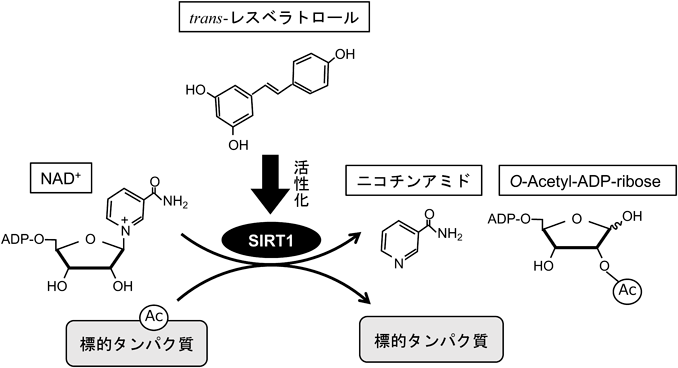sirt1について
Members of the sirtuin (SIRT) family of proteins are class III histone deacetylases (HDAC III) that are homologous to yeast silent information regulator 2 (Sir2). Sirtuins mediate the deacetylation of histones and non-histone proteins in an NAD+-dependent manner.
SIRT1 was the first SIRT to be discovered in mammals; it shares the highest homology with Sir2, and is the most extensively-studied SIRT protein that plays a role in promoting longevity . SIRT1-mediated deacetylation profoundly impacts multiple biological processes, including cellular senescence , apoptosis , sugar and lipid metabolism, oxidative stress , and inflammation .
Thus, even minor changes in SIRT1 expression and function can significantly impact cellular responses.
SIRT1 (Sir2) is an NAD+-dependent deacetylase that plays critical roles in a broad range of biological events, including metabolism, immune response, and aging. While there is strong interest in stimulating SIRT1 catalytic activity, the homeostasis of SIRT1 at the protein level is poorly understood.
Macroautophagy (hereafter referred as autophagy), a catabolic membrane trafficking pathway that degrades cellular components through autophagosomes and lysosomes, mediates downregulation of mammalian SIRT1 protein during senescence and in vivo aging.
In senescence, nuclear SIRT1 is recognized as an autophagy substrate and is subjected to cytoplasmic autophagosome-lysosome degradation, via the autophagy protein LC3. Importantly, the autophagy-lysosome pathway contributes to loss of SIRT1 during aging of several tissues related to the immune and hematopoietic system in mice, including spleen, thymus, and hematopoietic stem and progenitor cells, and in CD8+CD28- T cells from aged human donors.
Targeting SIRT1 signaling pathway could improve glucose aerobic metabolism and mitochondrial biosynthesis to resist cardiac and neurological injuries. Ginsenoside Rc has been identified for targeting mitochondrial function, but how ginsenoside Rc(a triterpene saponin found in species of Panax, including Panax ginseng. It exhibits various physiological effects, such as antioxidative, anti-aging, antinociceptive, and anti-diabetic activities1. Here are some key points about it: Chemical Structure: Ginsenoside Rc belongs to the dammarane-type saponins. It has a complex structure with multiple sugar moieties attached to a triterpene backbone. The chemical formula for ginsenoside Rc is C53H90O222. Sources: Ginsenoside Rc is primarily found in Panax ginseng, commonly known as Korean ginseng. It’s isolated from the roots of the plant and purified using column chromatography1. Biological Activities: Antioxidant: Ginsenoside Rc has been shown to have antioxidant properties, helping to reduce oxidative stress1. Anti-Diabetic: It may play a role in managing diabetes by modulating signaling pathways like PI3K/Akt1. Other Effects: Ginsenoside Rc inhibits phosphorylation of Foxo1, activates PI3K/Akt signaling, and increases catalase levels3. Remember that ginsenosides are complex molecules, and their effects can vary based on the specific type and the overall composition of the ginseng species. interacts with SIRT1 to regulate energy metabolism in cardiomyocytes and neurons under physiological or ischemia/reperfusion (I/R)-injured conditions has not been clearly investigated. Here, we confirm the interaction of Rc on the residue sites of SIRT1 in promoting its activity. Ginsenoside Rc significantly promotes mitochondrial biogenesis and increases the levels of electron-transport chain complex II-IV in cardiomyocytes and neurons. Meanwhile, ginsenoside Rc pretreatment increases ATP production, glucose uptake, and the levels of hexokinase I/II and mitochondrial pyruvate carrier I/II in both cell models. In addition, ginsenoside Rc activates the PGC1α pathway to induce mitochondrial biosynthesis. More importantly, ginsenoside Rc reduces mitochondrial damage and apoptosis through SIRT1 restoration-mediated reduction of PGC1α acetylation in the I/R-induced cardiac and neuronal models. Collectively, the in vitro and in vivo data indicate that ginsenoside Rc as a SIRT1 activator promotes energy metabolism to improve cardio- and neuroprotective functions under normal and I/R injury conditions, which provides new insights into the molecular mechanism of ginsenoside Rc as a protective agent.
レスベラトロール(trans-レスベラトロール;図1)はブドウの果皮や赤ワイン,そしてイタドリの根茎などに多く含まれているポリフェノールである.植物におけるレスベラトロールの作用は,植物の感染や紫外線といった刺激に反応して合成が亢進し,それらからの防御に関与すると考えられている.この食物由来物質は現在,医学・科学や医療の業界のみならず,健康食品,化粧品などさまざまな方面から注目を集めている.いわゆるフレンチ・パラドックス説の原因物質と想定されたのに引き続き,長寿遺伝子サーチュインを活性化することがわかって以来,レスベラトロールの生体内における作用およびその分子メカニズムが検討されてきた.
図1 レスベラトロールの化学構造とSIRT1によるNAD+依存性脱アセチル化反応
シロスタゾール(PDE3 阻害薬)は抗血小板薬として
臨床的に慢性動脈閉塞症や脳梗塞再発予防に使われてい
るが,その他,多面的作用を持つことが知られている.
その一つに,シロスタゾールは血管内皮細胞 eNOS 活
性を増加させる.シロスタゾールを血管内皮細胞に処理
すると,eNOS-Sirt1 依存的に酸化ストレスによる血管
内皮細胞老化を抑制できる.このシロスタゾールの
Sirt1 を介した抗老化作用が,DES(drug-elutind stents)
による再内皮化の抑制や Late stent thrombosis といっ
た有害作用に対して保護的に作用する可能性がある.
近年,Sirt1 は血管新生,発芽に大きな役割を果たして
いることがわかってきた.まず,3D 血管新生アッセイ
にて,Sirtuin ファミリーをノックダウンさせることに
より,Sirt1 が特異的に血管内皮細胞の血管新生活性に
重要な働きを行っていることが確認された.血管内皮
細胞にはすべての Sirtuin ファミリーが存在することが
わかっているが,Sirt1 を特異的に阻害するとその細胞
は血管新生,出芽が減少することも報告されている.血
管内皮特異的に Sirt1 を欠損させたマウスでは,生後虚
血ストレスのような血管新生を増加させるシグナルに対
して反応が少なくなることもわかっている
2024年7月31日 | カテゴリー:癌の病態生理と治療学, 生活習慣病, 創薬/AUTODOCK, 糖尿病 |






